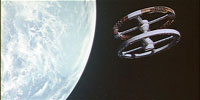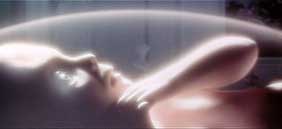
The music of Stanley Kubrick's 2001: A Space Odyssey has arguably become more familiar to us than the imagery of the film itself. From early in production, the director decided to create a largely non-verbal experience, rejecting the typical narrative structure of a historically or culturally founded story that is shaped by human personality and instead choosing music to do most of the work. By cutting out much dialogue, leaving long, uninterupted visual scenes, the music does just this.
One of the best examples of this is the space-station docking and lunar landing sequence that features "On The Beautiful Blue Danube", by Johann Strauss II. Here, the three-feel of the waltz parallels floating space crafts, weightless objects and people, capturing a sense of lightness and presenting one of the best interpretations of the issue of zero gravity in space films.
Richard Strauss's Sprach Zarathustra piece, which is powerful and percussive, is used at select moments of major discovery or revelation, such as the Apes' discovery of the bone as an instrument, and the final 'fetus' scene, which brings the story of life and history full circle.
Interestingly enough, all the music in the film was previously composed and performed. This choice was quite unusual, given that most major motion pictures being produced then and now have elaborate film scores and/or songs written for them by professional composers. Kubrick did, in fact, commission an original score from Hollywood composer Alex North, but in the end chose the classical pieces that the film team were using as musical guidelines throughout production. Kubrick commented on this in one inverview, saying:
"However good our best film composers may be, they are not a Beethoven, a Mozart or a Brahms. Why use music which is less good when there is such a multitude of great orchestral music available from the past and from our own time? When you are editing a film, it's very helpful to be able to try out different pieces of music to see how they work with the scene...Well, with a little more care and thought, these temporary tracks can become the final score."
In choosing a music-based structure rather than a typical narrative, Kubrick harks back to the silent film era, where music was the sole audio feature - no environmental sounds, and no dialogue.
Aelita: Queen of Mars is one such film that has no dialogue and only very basic black and white imagery. Produced in 1927, still close to the time of live, in-house music at screenings, piano music is favoured to project the mood of the scenes.
As this film is rich with revolutionary significance, portraying the actual and symbolic flight of one character, Loss, from his mundane domestic life in the post-war Soviet Union to the world of Mars where he encouters an alien race and leads an uprising against their leader, the music itself responds to these shifts. In response to the change of setting from the familiar, passive earth to the unfamiliar, hostile alien city, the piano score starts out fairly passive, ebbing and flowing through most of the scenes on earth. Eventually, as the setting changes to Mars and Loss discovers the alien race and finally fights their king, the music shifts to darker more minor tones, and finally ends with heavy, staccato notes during the battle scene.
Given that Aelita came out before the first travel into space and the discovery of no atmosphere and no gravity, these issues are not dealt with in the movie, and hence neither in the music. Nevertheless, the space theme of hostile environment is emoted strongly through the music.





.jpg)